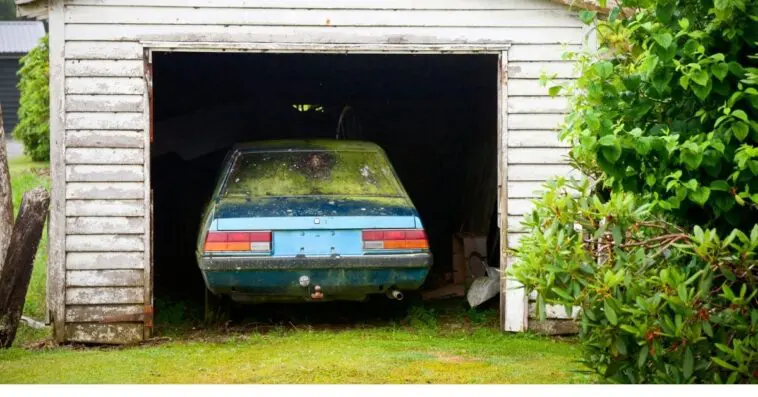All of us know how disturbing it can be if your car has a foul smell almost always.
While there are many ways to fix this, for prevention, you can, of course, buy a car freshener but have you ever noticed why the foul smell?
Well, if you haven’t yet, you must. Your car can be the prey to ugly round patches of molds.
So, how to get rid of mold in your car? There are simple methods like applying baking soda solution, dish wash solutions, non-iodized salt solution, etc.
However, if you are confident enough, you can also go for professional cleaning using enzyme-based chemicals available in most hardware shops.
TABLE OF CONTENTS
What Are Molds?
Molds are fungi that grow in the form of multi-cellular filaments known as hyphae. It appears as a discolored fuzzy patch growing on wood, aged metals, buildings, and other wet surfaces.
It causes biodegradation of natural materials as well as damage to private properties. Its hyphae or spores can even cause severe health issues.
Although it grows on dead stuff, it cannot be seen with the naked eye. It is only visible after it has muted several times and established colonies, and it is noteworthy that molds breed vigorously.
How Do Molds Grow In A Car?
There are several possible answers to this question. Molds flourish in wet environments. If you leave your car’s window or sunroof open on rainy days, mold will proliferate.
It is also possible if you leave a wet fabric or an old piece of wooden ply inside your car. You should also look for food crumbs on your seats, floor mats, and corners.
Molds and other fungi thrive in the presence of the substances mentioned above.
How To Find Molds In A Car
To begin with, avoid parking your vehicles in wet locations. Don’t forget to ventilate the interior of your car.
You may clean your car at regular intervals, but ventilation and interior hygiene are crucial.
Since molds can be present anywhere, it is essential that you wear your mask and, if required, plastic hand gloves while cleaning your car.
Molds can cause respiratory problems and a variety of other health problems.
Now, let’s look at how to locate mold in your car in steps:
- The first and most crucial step is to move your vehicle to a dry, sunny location.
- Allow fresh sunlight to enter your vehicle by opening the doors and windows.
- Begin by removing any movable or extra items from your vehicles, such as floor mats, documents, damp or soiled fabrics, or any other items.
- Remove the dry articles as well, since wetness might be challenging to detect at times. You never know what item is laying the groundwork for molds.
- Now start looking for white or any colored patches in every part of your car. Pay special attention to the less noticed areas like seat belts, storage area, seat covers, etc.
You may notice round patches at places. However, do not touch or approach them. Let’s find out how to tackle molds in the next section.
5 Materials Required For Cleaning
Before you get ready to tackle the molds, make sure to keep the following items handy with you. This is for your safety and convenience while cleaning.
1. Vacuum Cleaner
This would be needed to extract the dirt from the folds where you can’t reach easily. Dirt or residual objects can catch moisture easily, giving shelter to fungi.
2. Right Equipment
I recommend that you always keep spray bottles, sprinklers, or any other material appropriate for the solution you are using. This would avoid a last-minute rush.
3. Soft Fabric
Keep at least two pieces of cloth with you while cleaning—one for rubbing the solution and the other for cleaning the area. Keep as many clothes as possible.
Remember the material must be smooth enough for your car interior, or it would end up scratching the surface.
4. Material
Keep the solution you are using ready with you in the bottle or any container required—for example, vinegar, baking soda, pesticides, etc.
5. Safety Gears
Wear masks and gloves and cover your skin properly before cleaning. Fungi can easily get into your body, causing allergies or any other serious health issues.
5 Ways To Clean Mold In Your Car
There are numerous do-it-yourself methods for removing mold from your car. However, the application should be based on the material of your car’s interior and your comfort.
Almost all of the solutions listed here are reasonably priced and function well.
Note: Make sure to use the solution first on a sample material before using it in your car interior. Some solutions can be reactive to certain material and can cause side effects to the leather of your seat covers or mats, or any other part.
1. Vinegar Solution
Vinegar’s acidic nature is known to kill molds effectively. It also reduces the chance of its coming back. To make this solution, you need to mix white vinegar with water with a ratio of 8:2.
Stir the solution well and pour it into a clean bottle or spray bottle. I prefer a spray bottle over a standard bottle as it would help clean a large portion in less time.
Apply the solution to the affected area through sprinkling or by the use of a cloth. Leave it for 20-25 minutes to get soaked.
You can use a vacuum cleaner to clean the dead spores left on the surface. Clean it later with a dry cloth to avoid any further risk.
To get rid of the pungent smell of vinegar, you can use car fresheners or just let open the doors and windows for some time.
2. Non-Iodized Salt Solution
Make sure you use only non-iodized salt. Iodized salt can affect adversely. Take the same proportion of 8:10 salt and water. Mix them well on a big container.
Then spread the solution on the fungus-affected area and wait till the solution dries. When you see small lumps of salts, you can clean the surface.
Clean it with a vacuum cleaner or a brush. You must clear the surface once again with a dry cloth to avoid any trace of the fungi.
3. Oil Of Cloves
Oil of cloves is one of the cheapest ways to get rid of molds. It is readily available in a pharmacy or any regular chemical shop.
It is a very concentrated solution and thus, required to use in a minimal amount. Only one-fourth of a teaspoon must be added to one liter of water.
This solution is easier to apply. You don’t have to wait for it to dry up. You can keep the solution for as long as you want. The more it stays, the more effective it gets.
When you think it is enough, you can clean it up using a vacuum cleaner or dry cloth. Repeat the steps until the result is desirable.
4. Dish Soap Solution
You must be familiar with dishwashing soap. It is surprising to know that it can also be used to eliminate molds. Its antifungal formula helps in killing the molds effectively.
You can use the froth of the dishwashing soap to clean the interior of your car for perfect results.
However, you must check on a sample before using it. Dish soap solution can be reactive to certain material, destroying the seat cover material or the plastics.
After cleaning, dry the surface with a cloth and ventilate properly. You can roll down the windows to allow sunlight for further prevention.
5. Baking Soda Solution
You can use baking soda in the same way as the dish soap solution.
The alkalinity of baking soda makes it ideal for killing molds. The solution must contain one-fourth of baking soda with approximately 250ml of water.
Sprinkle the solution on the affected area, and you can brush or scrub that part for some time to get better results.
Leave it untouched for some time, and then you can clean it with clear water and cloth. Let it dry after cleaning and allow sunlight till the wetness persists.
Why Are Molds Dangerous?
Molds are highly hazardous to one’s health. In addition, it can damage your car like anything. It eats up the car surface and spoils the material.
If you ignore molds in the long term, it can make the car unhealthy to drive. Your car’s interior would become weak, and you will have to change the parts, which can cost a big bunch of money.
Driving in a car full of mold patches can make you prone to chronic diseases.
Health Problems Due To Molds
If you are feeling nauseous while driving or continuously sneezing, then it’s high time that you should do a mold test.
Molds can cause a lot of health issues to an individual. If you have any mold-related symptoms, you must immediately consult a doctor.
The spores present on the mold surface can easily spread by air or water. As the molds keep on colonizing, the number of spores increases. And eventually, they become noticeable.
The spores can get into your nose and cause various respiratory diseases like asthma, wheezing, coughing, allergies, etc.
Individuals having asthma must take extra precautions to keep their car clean. Such patients can suffer severely due to mold spores. In extreme cases, death can also occur.
If you suspect mold in your car and you immediately need to drive, I recommend a weak dusk mask before getting into the car. It can prevent spores from getting into your respiratory tract.
But this must not be considered as a permanent solution. You should clean it as soon as possible.
What Are Black Molds?
Black mold is the type of mold which is scientifically known as Stachybotrys chartarum.
According to much research, they are the most hazardous sort of mold. Although it may be too reactive in some populations, it is less reactive in those with a normal immune system.
If you notice black mold spreading in your car, you must act quickly. They can reproduce rapidly and cause you harm.
A bleeding nose, lung issues, lethargy, headaches, vomiting, and other symptoms are typical in persons affected by black mold.
When To Get Professional Help
It is highly advised that the above ways mentioned to get rid of molds are just home remedies, and if you think these are not working, you must take professional help or contact a car washing center.
To remove molds professionally, you can use top enzyme-based mold killers, which can be easily afforded from a hardware shop.
While you clean your car, make sure to clean the entire vehicle and spray the solution down the car to avoid re-infection.
How To Prevent Mold Growth
There are many ways by which you can keep your car hygienic inside-out. All you have to do is to follow the tips below:
- Ventilate your car. Proper ventilation and sunlight are essential to keep the car protected from microbes.
- Use a dehumidifier to keep the humidity under control.
- Do not expose your car to moisture.
- Avoid keeping wet clothes or wooden slabs inside your car.
- Try not to eat inside the car. It makes the interior dirty and attracts fungus.
Frequently Asked Questions
Q1. Can Broken Windows Promote The Growth Of Molds?
Yes, broken windows allow air and moisture to get into your car while you are not around. It creates a humid environment inside the car which promotes the growth of molds.
Q2. Can Frequent Use Of Air Conditioner Cause Molds?
Mold growth in a vehicle’s air conditioning system is a possibility. You must clean it regularly to avoid any discrepancies.
Q3. Can Water-Proved Floor Mating Prevent Molds?
Waterproof floor mating is a friendly choice. However, it does not reduce the risk of mold growth to zero. Frequent cleaning is the only way to prevent molds from colonizing.
Conclusion
Do not make any decisions based on your instincts.
To brief, I recommend you to timely service your car and keep a check on it. You must not avoid cleaning just because you can’t see anything or not getting any foul smell.
Cleaning them before they start mutating is the best prevention method. You can be your boss with a bit of regularity and research.
Clean the moisture leaks immediately and save your car and yourself from the hazardous molds. Both life and cars are expensive!




